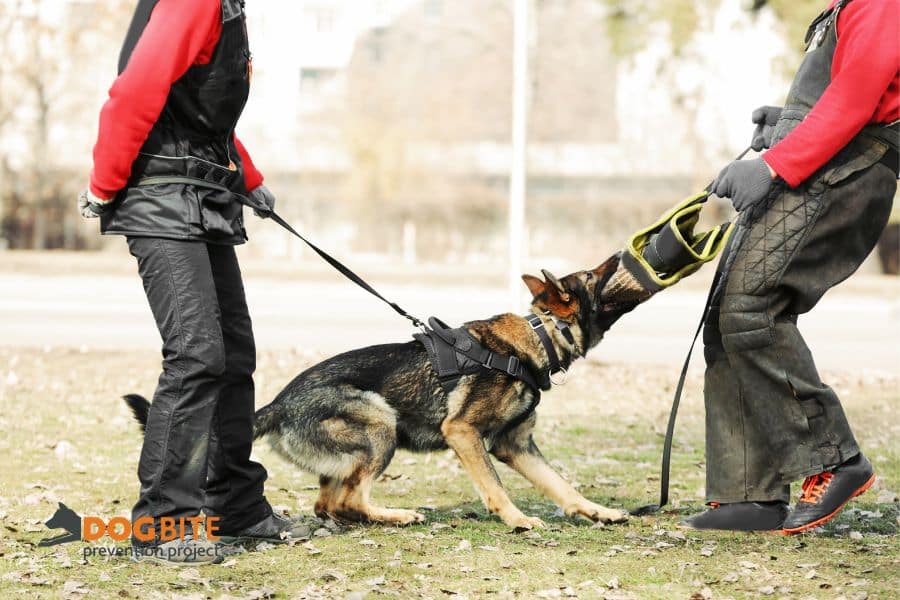One question we get asked more than any other is about the use of live dogs for training – and more specifically why we don’t use live animals for our in person dog bite prevention program.
The short answer is, after training hundreds of veterinary students, Animal Management professionals, shelter workers, and workplace participants over the past decade we don’t believe there are increased benefits or improved outcomes for participants when working with live animals.
Of course the long answer is slightly more complex.
Increasingly in Australia, New Zealand, the US, and Europe the use of live animals for training purposes is considered suboptimal – particularly for training like ours that focuses on early risk assessment and intervention.
Ethical concerns
As Fear Free Certified practitioners, we believe strongly that using live dogs for training purposes comes with significant ethical problems.
A key component of our dog bite prevention training is teaching how dogs experience and subsequently communicate fear, anxiety, and stress. No matter how well trained when placed in unfamiliar or physically demanding situations asked to repeatedly simulate a stress response, or perform high-stress behaviours animals are significantly impacted both physically and psychologically.
Not only does this put the animal at risk but also places participants at higher risk of being bitten or attacked during a training session.
Training outcomes
Traditionally the use of live trained dogs has been a strong selling point for service providers with a background handling or training service dogs (police and/or defence dogs).
Whilst many of these trainers have a strong professional background working with highly reactionary animals, they generally don’t have professional knowledge, training, or ongoing access to best practice around more nuanced behaviours and body language demonstrated by the majority of animals.
Live animals certainly lend themselves to a more experiential (and dramatic) training experience but don’t necessarily deliver the kind of knowledge that’s valuable in a workplace.
In addition to this due to their unique temperament, skill level, and response pattern live dogs also create variability in training which can be impacted by their mood, health and previous experiences.
Unlike using video footage or new interactive technologies, this variability makes it difficult to standardise training protocols and outcomes as well as repeat or review behaviours for greater understanding.

A focus on desired outcomes
As an experienced animal behaviour veterinarian, I believe animals that have been trained to simulate or demonstrate high-stress behaviours in response to particular commands or stimuli, rarely if ever demonstrate the subtle, nuanced behaviours anxious, stress, or fearful dogs show in their natural environment.
Recognising and responding to these subtle (orange zone) body language and behavioural changes is critical in effectively assessing risk and responding to that risk before it reaches a crisis point.
Our training focuses on developing skills and knowledge that help participants avoid a bite or attack where-ever possible, not react to a crisis. Training with live dogs, as a general rule, focuses on withstanding the physical and psychological impacts an unwanted bite or attack.
Participant impact
Working with Animal Management Officers across Australia has enabled us to gain a unique perspective on what effect ‘suiting up’ (withstanding a simulated attack scenario) has on the mental health of participants.
Participants report feeling everything from mild anxiety through to deep trauma. For participants who have existing anxiety or fear around dogs this style of training can leave them feeling unempowered and constantly fearful that any dog will attack at any time.
Conversely participants who have been taught strategies that help them assess the fear, anxiety, and stress (FAS) level of dogs they encounter, determine their risk, and make early decisions around their safety – feel more empowered to use proactive safety protocols (speaking to dog owners, withdrawing from the job, asking for additional safety measures etc).
We believe training participants for an attack doesn’t provide enough knowledge, skill, or information to establish early intervention protocols or avoid a potentially critical outcome.
Advanced alternatives
Whilst our current training programs utilise extensive close up video footage of dogs demonstrating a wide range of core behaviours and body language, we’re excited to be working with leading developers in 3D technology to provide even greater insight into common scenarios and in turn offer an even higher level of consistency, repeatability, and control – without the ethical and practical concerns associated with live animals.
For more information about our training contact us at info@dbpp.com.au
